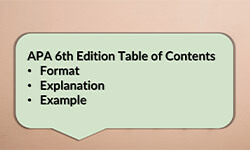
When you’re working on a research paper, organizing your work can make everything a lot easier. That’s where an APA 6th edition table of contents is helpful. If you’re using APA style, especially the APA 6th edition, there are specific rules about how to set up your table of contents. This helps everyone understand how your paper is organized. In academic writing, following a certain style can make your work look professional and easy to follow.
Definition: APA 6th edition table of contents
A table of contents is an organized list of a paper’s headings and subheadings, placed between the abstract and introduction, which includes corresponding page numbers and follows consistent formatting and spacing rules.
in Your Thesis
APA 6th edition table of contents: Format
- The table of contents should be situated between the abstract and the introduction of your paper.
- Format the heading on the page as “Table of Contents” using boldface and center alignment.
- Employ a legible font consistently throughout your document.
- Ensure the table of contents is double-spaced.
- Enumerate all headings and subheadings, accompanied by their respective page numbers.
- Adhere to a consistent formatting style for all headings and subheadings.
- Lastly, align the page numbers to the right margin of the document.
Sections of APA 6th edition table of contents
Structuring the table of contents and the entire paper enhances readability. Employing headings and subheadings is crucial for facilitating quick location of desired information. It is imperative to ensure that both headings and subheadings are effectively utilized in the main body of the paper. In the subsequent sections, primary headings will be briefly defined.
-
Introduction
This section introduces the research topic, provides background information, discusses the purpose and
-
Literature review
This section provides an overview of previous research related to the topic, discusses relevant theories and models, identifies gaps in the literature, and summarizes the literature review.
-
Methodology
This section describes the research design, including the participants, measures and instruments used, procedures followed, and data analysis methods.
-
Results
This section presents the findings of the study, including descriptive statistics, inferential statistics, and results of hypothesis testing.
-
Discussion
This section provides an interpretation of the results, discusses the implications and contributions of the study to the field, identifies limitations of the study, and suggests future research directions.
-
Conclusion
This section summarizes the study, provides implications for practice, and offers final thoughts.
-
References
This section lists all sources cited in the paper, following APA citation guidelines.
-
Appendices
Includes supplementary materials related to the study, such as consent forms, survey instruments, or interview transcripts.
Exemplary table of contents
FAQs
A table of contents is not typically required for shorter papers, but it can be helpful for organizing longer research papers, theses, or dissertations.
It is important to use a consistent font, double-space the entire table, and format headings consistently with page numbers. Page numbers should be aligned to the right margin, and headings and subheadings should be listed with appropriate formatting (e.g., bold for main headings, italics for subheadings).
In this discussion, we’ll go over how to create a table of contents that fits with APA style and the APA 6th edition guidelines. We’ll look at what should be included, how to format it, and why it’s important. This will help make your academic writing project clearer and more organized.
